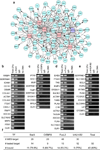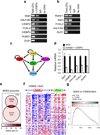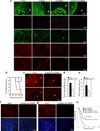The transcriptional network for mesenchymal transformation of brain tumours
- PMID: 20032975
- PMCID: PMC4011561
- DOI: 10.1038/nature08712
The transcriptional network for mesenchymal transformation of brain tumours
Abstract
The inference of transcriptional networks that regulate transitions into physiological or pathological cellular states remains a central challenge in systems biology. A mesenchymal phenotype is the hallmark of tumour aggressiveness in human malignant glioma, but the regulatory programs responsible for implementing the associated molecular signature are largely unknown. Here we show that reverse-engineering and an unbiased interrogation of a glioma-specific regulatory network reveal the transcriptional module that activates expression of mesenchymal genes in malignant glioma. Two transcription factors (C/EBPbeta and STAT3) emerge as synergistic initiators and master regulators of mesenchymal transformation. Ectopic co-expression of C/EBPbeta and STAT3 reprograms neural stem cells along the aberrant mesenchymal lineage, whereas elimination of the two factors in glioma cells leads to collapse of the mesenchymal signature and reduces tumour aggressiveness. In human glioma, expression of C/EBPbeta and STAT3 correlates with mesenchymal differentiation and predicts poor clinical outcome. These results show that the activation of a small regulatory module is necessary and sufficient to initiate and maintain an aberrant phenotypic state in cancer cells.
Figures





Similar articles
-
Interleukin-6 induces malignant transformation of rat mesenchymal stem cells in association with enhanced signaling of signal transducer and activator of transcription 3.Cancer Sci. 2014 Jan;105(1):64-71. doi: 10.1111/cas.12313. Epub 2013 Dec 30. Cancer Sci. 2014. PMID: 24168060 Free PMC article.
-
RTVP-1 promotes mesenchymal transformation of glioma via a STAT-3/IL-6-dependent positive feedback loop.Oncotarget. 2015 Sep 8;6(26):22680-97. doi: 10.18632/oncotarget.4205. Oncotarget. 2015. PMID: 26267319 Free PMC article.
-
Aberrant mesenchymal differentiation of glioma stem-like cells: implications for therapeutic targeting.Oncotarget. 2015 Oct 13;6(31):31007-17. doi: 10.18632/oncotarget.5219. Oncotarget. 2015. PMID: 26307681 Free PMC article.
-
Developmentally regulated signaling pathways in glioma invasion.Cell Mol Life Sci. 2018 Feb;75(3):385-402. doi: 10.1007/s00018-017-2608-8. Epub 2017 Aug 18. Cell Mol Life Sci. 2018. PMID: 28821904 Free PMC article. Review.
-
Stem cell signature in glioblastoma: therapeutic development for a moving target.J Neurosurg. 2015 Feb;122(2):324-30. doi: 10.3171/2014.9.JNS132253. Epub 2014 Nov 14. J Neurosurg. 2015. PMID: 25397368 Review.
Cited by
-
Malignant glioma: lessons from genomics, mouse models, and stem cells.Cell. 2012 Mar 30;149(1):36-47. doi: 10.1016/j.cell.2012.03.009. Cell. 2012. PMID: 22464322 Free PMC article. Review.
-
Tamoxifen improves cytopathic effect of oncolytic adenovirus in primary glioblastoma cells mediated through autophagy.Oncotarget. 2015 Feb 28;6(6):3977-87. doi: 10.18632/oncotarget.2897. Oncotarget. 2015. PMID: 25738357 Free PMC article.
-
Transcriptional regulatory networks of tumor-associated macrophages that drive malignancy in mesenchymal glioblastoma.Genome Biol. 2020 Aug 26;21(1):216. doi: 10.1186/s13059-020-02140-x. Genome Biol. 2020. PMID: 32847614 Free PMC article.
-
The "Janus" Role of C/EBPs Family Members in Cancer Progression.Int J Mol Sci. 2020 Jun 17;21(12):4308. doi: 10.3390/ijms21124308. Int J Mol Sci. 2020. PMID: 32560326 Free PMC article. Review.
-
Embryonic stem cell preconditioned microenvironment suppresses tumorigenic properties in breast cancer.Stem Cell Res Ther. 2016 Jul 27;7(1):95. doi: 10.1186/s13287-016-0360-x. Stem Cell Res Ther. 2016. PMID: 27460364 Free PMC article.
References
-
- Ohgaki H, Kleihues P. Population-based studies on incidence, survival rates, and genetic alterations in astrocytic and oligodendroglial gliomas. J Neuropathol Exp Neurol. 2005;64:479–489. - PubMed
-
- Demuth T, Berens ME. Molecular mechanisms of glioma cell migration and invasion. J Neurooncol. 2004;70:217–228. - PubMed
-
- Kargiotis O, Rao JS, Kyritsis AP. Mechanisms of angiogenesis in gliomas. J Neurooncol. 2006;78:281–293. - PubMed
-
- Phillips HS, et al. Molecular subclasses of high-grade glioma predict prognosis, delineate a pattern of disease progression, and resemble stages in neurogenesis. Cancer Cell. 2006;9:157–173. - PubMed
-
- Tso CL, et al. Primary glioblastomas express mesenchymal stem-like properties. Mol Cancer Res. 2006;4:607–619. - PubMed
Publication types
MeSH terms
Substances
Associated data
- Actions
- Actions
Grants and funding
- R01 CA127643/CA/NCI NIH HHS/United States
- U54CA121852/CA/NCI NIH HHS/United States
- 1RC2CA148308-01/CA/NCI NIH HHS/United States
- R01 CA190891/CA/NCI NIH HHS/United States
- R01 CA101644/CA/NCI NIH HHS/United States
- U54 CA121852/CA/NCI NIH HHS/United States
- R01 AI066116/AI/NIAID NIH HHS/United States
- R01CA085628/CA/NCI NIH HHS/United States
- R01 NS061776/NS/NINDS NIH HHS/United States
- R01NS061776/NS/NINDS NIH HHS/United States
- RC2 CA148308/CA/NCI NIH HHS/United States
- R01 CA085628/CA/NCI NIH HHS/United States
- R01CA101644/CA/NCI NIH HHS/United States
- U01 CA168426/CA/NCI NIH HHS/United States
- P20 GM075059/GM/NIGMS NIH HHS/United States
- R01CA109755/CA/NCI NIH HHS/United States
- R01 CA109755/CA/NCI NIH HHS/United States
- P20GM075059/GM/NIGMS NIH HHS/United States
LinkOut - more resources
Full Text Sources
Other Literature Sources
Medical
Molecular Biology Databases
Miscellaneous

